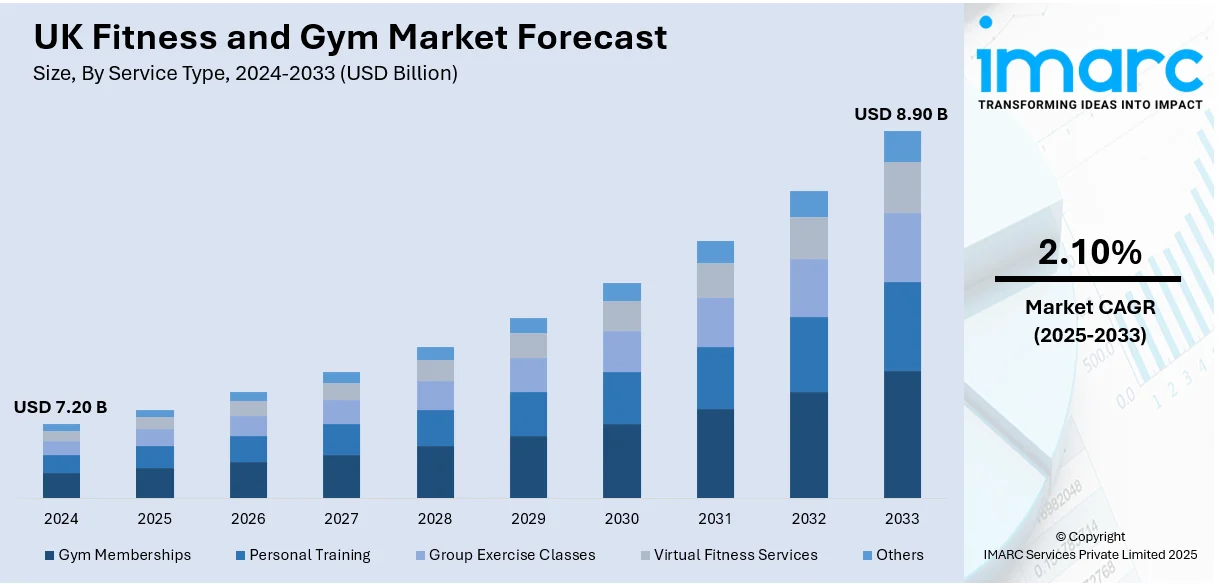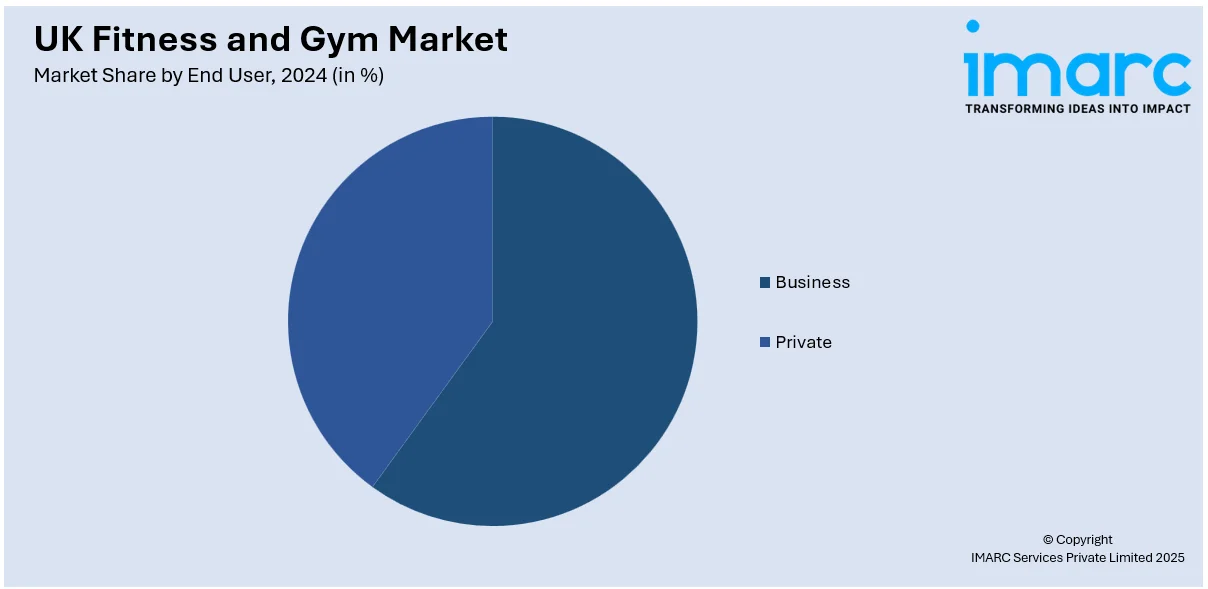
UK Fitness and Gym Market Size, Share, Trends and Forecast by Service Type, Business Model, End User and Region, 2025-2033
UK Fitness and Gym Market Overview:
The UK fitness and gym market size reached USD 7.20 Billion in 2024. Looking forward, IMARC Group expects the market to reach USD 8.90 Billion by 2033, exhibiting a growth rate (CAGR) of 2.10% during 2025-2033. The market is experiencing robust growth, mainly driven by increasing health awareness, the rise of boutique and budget gyms, digital and hybrid fitness solutions, and a focus on wellness. Expanding eco-friendly gyms and wearable fitness technology also contribute to the sector's innovation and appeal to a diverse consumer base, while further expanding the UK fitness and gym market share.
|
Report Attribute
|
Key Statistics
|
|---|---|
|
Base Year
|
2024 |
|
Forecast Years
|
2025-2033
|
|
Historical Years
|
2019-2024
|
| Market Size in 2024 | USD 7.20 Billion |
| Market Forecast in 2033 | USD 8.90 Billion |
| Market Growth Rate 2025-2033 | 2.10% |
UK Fitness and Gym Market Trends:
Rise of Digital and Hybrid Fitness
The emergence of digital and hybrid fitness has revolutionized the way consumers engage in their workout regimens by combining the ease of technology with the traditional gym experience. Through fitness apps, live streaming, and on-demand programming, users can enjoy a wide variety of workouts ranging from yoga to high-intensity interval training (HIIT) from the comfort of their homes. This change has also allowed gyms to reach further than just their physical space so that they can connect with members all over the world. Hybrid fitness models have shifted the UK fitness and gym market outlook toward schedule flexibility but also toward individualization with the help of AI-based fitness plans, tracking of progress, and virtual personal trainers. In accord with this, the possibility to attend live classes creates communal interaction that covers between virtual convenience and communal experience of face-to-face exercise. For example, in October 2023, Dyaco UK and Hybrid Fitness in Loughton launched their collaboration to introduce a flagship fitness center. This partnership introduces the latest technology to provide state-of-the-art cardio equipment, strength training equipment, and innovative group fitness solutions to enrich members' training experience. The alliance seeks to develop the best fitness hub in Loughton with a focus on health and wellness.

Sustainability and Eco-Friendly Gyms
Sustainability is now an area of increasing interest in the fitness sector, which has created eco-friendly gyms throughout the UK. The gyms strive to minimize their carbon footprint through energy-efficient equipment like self-generating treadmills and bikes that power electricity as one works out. Buildings are constructed using sustainable materials like recycled flooring and environmentally friendly construction techniques. Moreover, most of these gyms place importance on water saving, waste minimization, and the utilization of alternative energy sources. Green gyms also promote environmentally friendly practices among members by providing reusable water stations and advocating green fitness equipment. Such initiatives not only minimize environmental footprint but also resonate with the increasing number of consumers that place importance on sustainability in their life choices. For example, in September 2023, purpose-driven gym chain the Gym Group reached carbon neutral status, with it being the first UK gym chain to do so. Having committed to cutting carbon emissions by 50% by 2030 and reaching net zero by 2045, the group is actively investing in high-quality offsetting projects. Its strategy is to use 100% renewable energy, replace lighting systems with upgraded ones, and introduce efficient waste management. These initiatives support their dedication to sustainability and environmental stewardship, further propelling the UK fitness and gym market growth.
UK Fitness and Gym Market Segmentation:
IMARC Group provides an analysis of the key trends in each segment of the market, along with forecasts at the regional level for 2025-2033. Our report has categorized the market based on service type, business model, and end user.
Service Type Insights:
- Gym Memberships
- Personal Training
- Group Exercise Classes
- Virtual Fitness Services
- Others
The report has provided a detailed breakup and analysis of the market based on the service type. This includes gym memberships, personal training, group exercise classes, virtual fitness services, and others.
Business Model Insights:
- Low-Cost Gyms
- Station Based
- Free Floating
The report has provided a detailed breakup and analysis of the market based on the business model. This includes low-cost gyms, station-based, and free floating.
End User Insights:

- Business
- Private
The report has provided a detailed breakup and analysis of the market based on the end user. This includes business and private.
Regional Insights:
- London
- South East
- North West
- East of England
- South West
- Scotland
- West Midlands
- Yorkshire and The Humber
- East Midlands
- Others
The report has also provided a comprehensive analysis of all the major regional markets, which include London, South East, North West, East of England, South West, Scotland, West Midlands, Yorkshire and The Humber, East Midlands, and others.
Competitive Landscape:
The market research report has also provided a comprehensive analysis of the competitive landscape. Competitive analysis such as market structure, key player positioning, top winning strategies, competitive dashboard, and company evaluation quadrant has been covered in the report. Also, detailed profiles of all major companies have been provided.
UK Fitness and Gym Market News:
- In July 2024, Gymbox partnered with Raza Sana and Haringey Council to launch a community street gym in Tottenham, aiming to transform the lives of disadvantaged young people through fitness and calisthenics. The project includes free exercise classes and the Gymbox Academy, which offers training and qualifications for those on the 1st Rep programme. This initiative is part of Gymbox's broader effort to invest in local park gyms and support individuals from all backgrounds in entering the fitness industry.
- In November 2023, Fitness Superstore, the UK's top specialist fitness equipment retailer, partnered with Zack George, renowned CrossFit athlete and 2020's UK's Fittest Man. Zack joins the Body Power ProTeam, equipping his gyms with top-notch gear from Body Power and REP Fitness. The collaboration aims to create valuable fitness content for all levels. With 11 showrooms across the UK, Fitness Superstore offers a wide range of home fitness products and expert advice.
UK Fitness and Gym Market Report Coverage:
| Report Features | Details |
|---|---|
| Base Year of the Analysis | 2024 |
| Historical Period | 2019-2024 |
| Forecast Period | 2025-2033 |
| Units | Billion USD |
| Scope of the Report |
Exploration of Historical Trends and Market Outlook, Industry Catalysts and Challenges, Segment-Wise Historical and Future Market Assessment:
|
| Service Types Covered | Gym Memberships, Personal Training, Group Exercise Classes, Virtual Fitness Services, Others |
| Business Models Covered | Low-Cost Gyms, Station Based, Free Floating |
| End Users Covered | Business, Private |
| Regions Covered | London, South East, North West, East of England, South West, Scotland, West Midlands, Yorkshire and The Humber, East Midlands, Others |
| Customization Scope | 10% Free Customization |
| Post-Sale Analyst Support | 10-12 Weeks |
| Delivery Format | PDF and Excel through Email (We can also provide the editable version of the report in PPT/Word format on special request) |
Key Questions Answered in This Report:
- How has the UK fitness and gym market performed so far and how will it perform in the coming years?
- What is the breakup of the UK fitness and gym market on the basis of service type?
- What is the breakup of the UK fitness and gym market on the basis of business model?
- What is the breakup of the UK fitness and gym market on the basis of end user?
- What is the breakup of the UK fitness and gym market on the basis of region?
- What are the various stages in the value chain of the UK fitness and gym market?
- What are the key driving factors and challenges in the UK fitness and gym market?
- What is the structure of the UK fitness and gym market and who are the key players?
- What is the degree of competition in the UK fitness and gym market?
Key Benefits for Stakeholders:
- IMARC’s industry report offers a comprehensive quantitative analysis of various market segments, historical and current market trends, market forecasts, and dynamics of the UK fitness and gym market from 2019-2033.
- The research report provides the latest information on the market drivers, challenges, and opportunities in the UK fitness and gym market.
- Porter's five forces analysis assist stakeholders in assessing the impact of new entrants, competitive rivalry, supplier power, buyer power, and the threat of substitution. It helps stakeholders to analyze the level of competition within the UK fitness and gym industry and its attractiveness.
- Competitive landscape allows stakeholders to understand their competitive environment and provides an insight into the current positions of key players in the market.
Need more help?
- Speak to our experienced analysts for insights on the current market scenarios.
- Include additional segments and countries to customize the report as per your requirement.
- Gain an unparalleled competitive advantage in your domain by understanding how to utilize the report and positively impacting your operations and revenue.
- For further assistance, please connect with our analysts.
 Inquire Before Buying
Inquire Before Buying
 Speak to an Analyst
Speak to an Analyst
 Request Brochure
Request Brochure
 Request Customization
Request Customization




.webp)




.webp)












